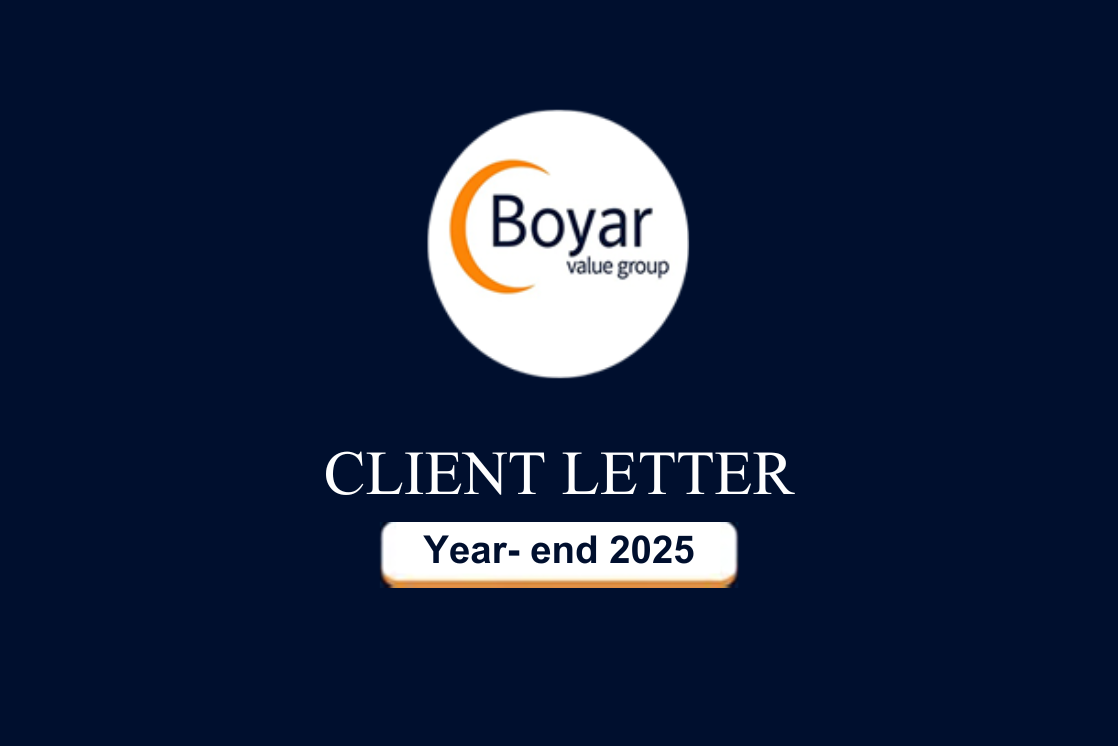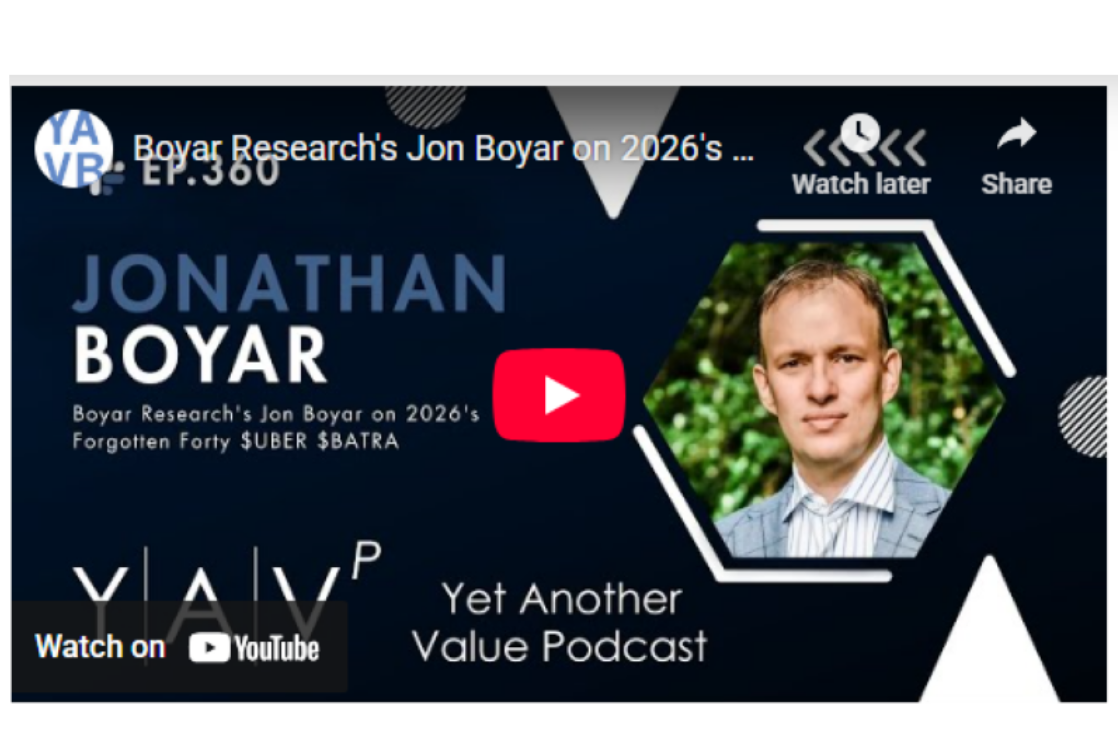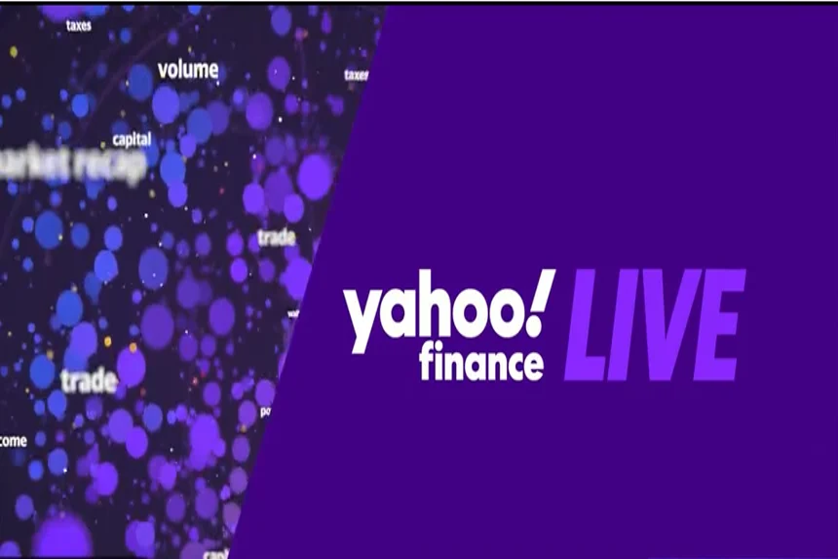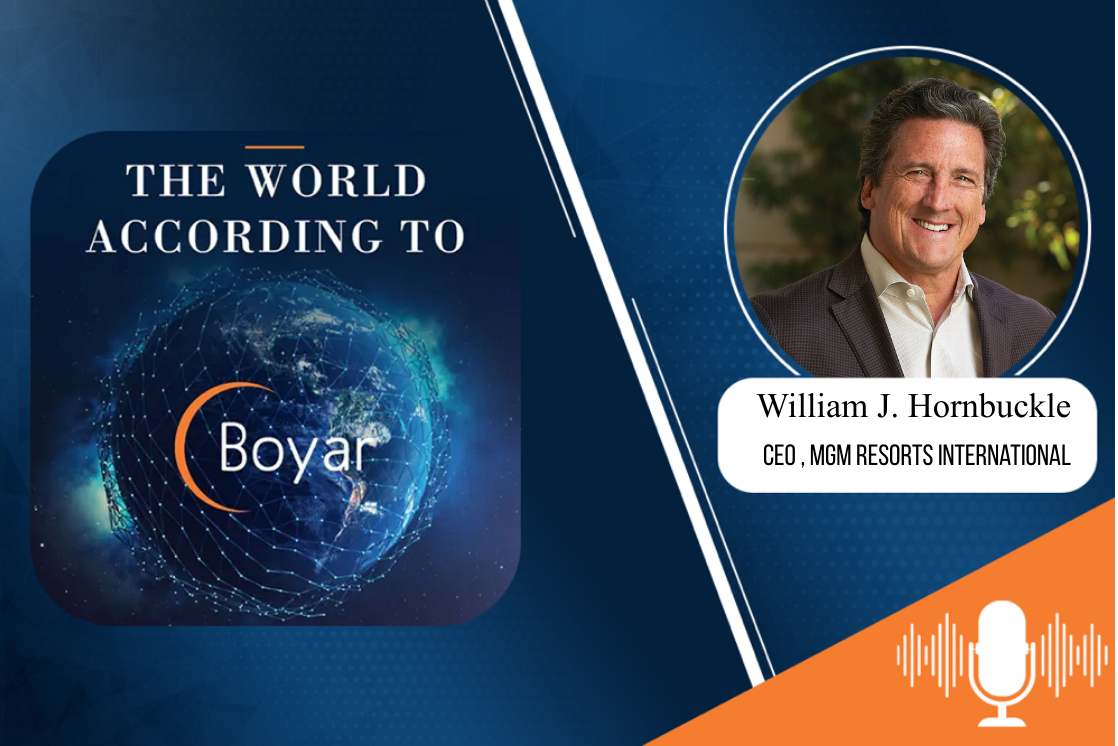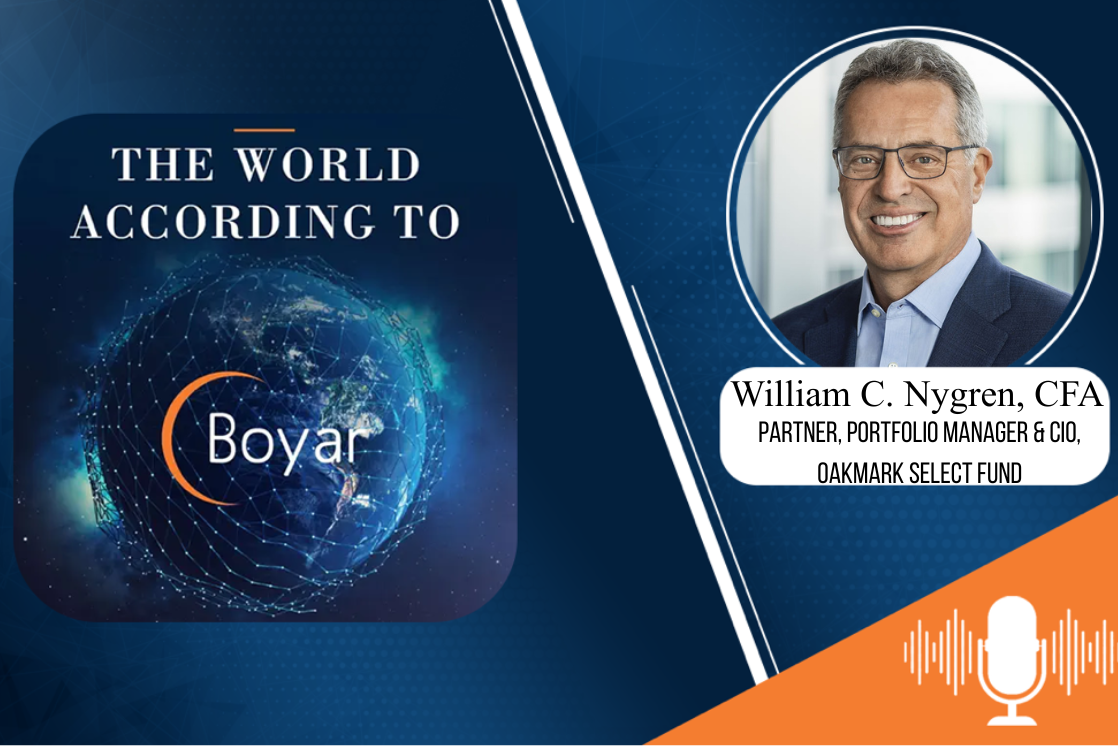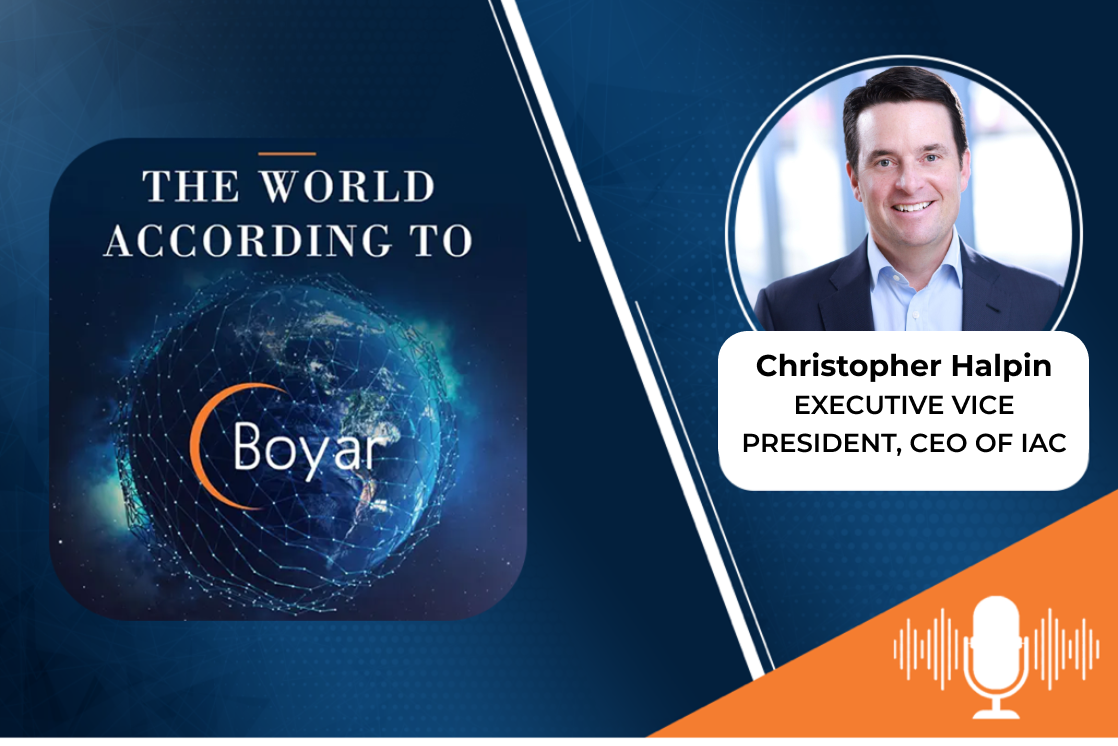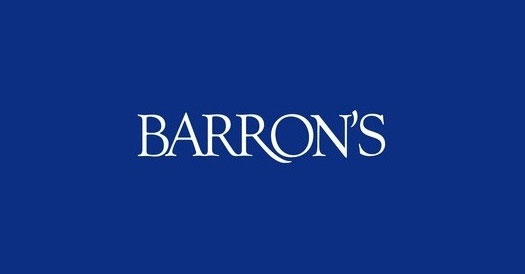Mario Gabelli, Chairman & CEO of GAMCO Investors, Inc., on portfolio construction and who he believes could be the next John Malone.
Howard Lorber, CEO of Vector Group, Chairman of Douglas Elliman, Chairman of Nathan's famous, on the New York real estate business and how he believes technology will impact the real estate brokerage business. - Value Investing Podcast
Jonathan Boyar Interviewed on Yahoo Finance - Boyar Value Group
Steve Einhorn, Vice Chairman of Omega Advisors, Inc., on investing in an unpredictable political environment and how Omega blends microeconomics with fundamental investing. - Value Investing Podcast
The interview discusses:
- His decision to start his own firm in the 1970s despite a horrendous economic backdrop;
- His new book Merger Masters that he wrote with Kate Welling;
- The rationale behind taking his company public and whether he would do it again;
- His thoughts on portfolio construction including how many positions should be in a portfolio and how long it takes him to become fully invested for a new account;
- How he incorporates tax ramifications into his sell decisions;
- His strategy of what to do when a stock within his portfolio increases or decreases by a significant percentage in a short period of time;
- Who he believes could be the next John Malone;
- His thoughts on Discovery Communications, Madison Square Garden and Disney.
About Mario Gabelli:
Mario J. Gabelli is the Chairman and Chief Executive Officer of GAMCO Investors, Inc., the firm he founded in 1977 that currently manages over $40 billion. A 1965 summa cum laude graduate of Fordham University’s College of Business Administration, he also holds an M.B.A. from Columbia University Graduate School of Business. He was Morningstar’s Portfolio Manager of the Year in 1997. He was named Money Manager of the Year by Institutional Investor for 2011 and is member of Barron’s All-Star Century Team.
Click Below to Read the Interview Transcript
Transcript Of The Interview With Mario Gabelli:
Jonathan Boyar (00:10):
Welcome to The World According To Boyar where we bring top investors, bestselling authors, and market news makers to show you the smartest ways to uncover value in the stock market. I’m your host, Jonathan Boyar.
Jonathan Boyar (00:23):
Today’s special guest, Mario Gabelli is a man who truly needs no introduction. After working at Loeb, Rhoades and William Witter, he formed his own firm, Gabelli & Company in 1976. Today he’s one of Wall Street’s best known investors and his publicly-traded firm GAMCO Investors manages over $40 billion utilizing primarily his private market value with a catalyst strategy. Today’s interview is especially exciting for me as Mario was my first boss after graduating from college. Mario, welcome to the show.
Mario Gabelli (00:56):
Well, terrific to be on the program. Obviously, I’ve known the Boyar family for probably close to 45 years. We used to have lunches in the 70s when there were very few of us around. 1970s, before somebody says 18 or 1670s.
Jonathan Boyar (01:10):
I wasn’t going to make that joke. Mario, you left a high-paying job at a well-respected Loeb, Rhoades, worked briefly at William Witter and then went off on your own. At the time the economy was awful, negotiated rates had ended, you had young children. What were you thinking?
Mario Gabelli (01:27):
What was I thinking? The answer is I thought it was a great time to be buying stocks, Jon. Prior to that for 10 years as a sell-side analyst, I covered a variety of industries. I graduated from local business school here at Columbia and I went to work on a Monday. Mike Steinhardt quit on a Friday. I picked up his industries, which were autos, farm equipment and conglomerates. Then fast forward a year or two later, I was assigned business services and I picked up the entertainment industry.
Mario Gabelli (01:52):
I was able to go through the environment of 1969, ’70, which was somewhat nasty, but quick and came out with some fairly easy stocks. Then I knew that I could select stocks in the ’73, ’74 economic downturn. The question was would I have enough money to be in business? I tried to raise a million dollars. I was only lucky enough to raise 200,000. I set off. I said, “Look, at some point money follows returns. If I could make returns for clients risk-adjusted, we basically hopefully will be okay.”
Mario Gabelli (02:26):
We started as an institutional sell-side firm. I got companies like General Motors and three or four other companies to actually buy my research for cash, which paid for some of the expenses. We had some institutional clients and then within a month or so, I picked up my first money managed account.
Jonathan Boyar (02:45):
I want to talk a little bit about your process. If a client walks in the door today at GAMCO, puts no restrictions, says invest in whatever you think is your best stocks. What would be the ideal number of holdings you would buy for him or her?
Mario Gabelli (02:58):
We would start asking simple questions. Have they been in the market before? Did you go through a period like 1987? Did you go through a period like 2000? Did you go through a period like 2008 or ’09? What happened to you if you were in the market in February of 2009? How long is your time-frame? What percentage of your assets? Depending on those answers, we could generally construct a portfolio that have 10 stocks that would represent a quarter of the portfolio and probably 70 or 80 representing the balance.
Mario Gabelli (03:31):
That doesn’t matter Jon, if they’d give me $1 million or $100 million. We would try to customize. Secondly, if it’s an IRA account, we would want to know that, or a 401k or a defined benefit or a tax free, because we tend to hold things for six, seven or eight years. But occasionally, we look at determining whether it’s not only what you make, it’s what you keep. In an environment where if a client comes in from California or New York City where they’re taking 13% of his earnings, if it’s short-term gains that are nondeductible because the SALT taxes, we want to be extra sensitive to all of that.
Jonathan Boyar (04:10):
That leads a perfect segue to my next question. For us in the 2009 period, we bought companies like MSG, Home Depot for clients. They were great stocks, still are great stocks. But because of capital appreciation, they’re now an outsize part of the portfolio, sometimes 7%, 8%. How do you handle situations like that?
Mario Gabelli (04:31):
Yeah, we have a nosebleed. No matter how good we are, there’s always some dynamic that you don’t know about. For somebody will come down and do something that says, “Okay, whoa.” The stock at 8% of the portfolio we say we want to trim it back. Our basic approach with generally, not for everyone, we would look at something that exceeds 5% or 6% and sell a couple of hundred shares. If you own 2,000 shares of Home Depot and it’s now $200 and you bought it at $15, we apologize, but we’re going to make you pay tax because we don’t want to own that much in the portfolio.
Jonathan Boyar (05:08):
It’s patriotic too.
Mario Gabelli (05:09):
It’s tough. Unfortunately, the real estate lobby has been very good at doing exchanges, Section 1031. But what is more hideous to the system and to the investor and to the owner of American business is the notion that company A buys company B and it’s a taxable transaction and you have no choice and you have to incur a very sizable gain.
Mario Gabelli (05:31):
We had that with Precision Castparts with Warren Buffett. We’re not unhappy with the price. We’re unhappy with the fact that we’re going to pay a toll tax of reinvestment. At some point, there’s financial illiterates that want it mark to market and tax you on mark to market gains. On the other side of the spectrum, you have to incur a tax for taxable accounts. For tax free accounts, Jonathan, the answer is fairly simple. We just sell it.
Jonathan Boyar (05:56):
Sometimes you have stocks that are extremely undervalued, may go down 20%, 30% in a day due to a reason that’s temporary, just a bump in the road. How do you handle that? Do you buy immediately? Do you wait for things to settle down to afford catching a falling knife? How does that work?
Mario Gabelli (06:14):
Well, that’s an interesting question as well. In theory and generally, for most of the stocks we follow, we have, today we have 40 analysts. We didn’t have 40 analysts 45 years ago. We had one, or 50 years ago when we started. They basically, the analysts prepare a spreadsheet. They gathered the data. They rated the data the way we want, in the value side of the house, not necessarily in other parts of our firm. We try to figure out, and this is for about 80% or 90% of what we do, what is the value of the business over time? When Mr. Market, that is the volatility in the market sends it up sharply or sharply down relative to what we think, we go through the positions. For new clients, we would probably start adding some because we’ll never catch Y.
Mario Gabelli (06:59):
Right now a good example, Jon, is the MAX 737. There are vendors to Boeing four months ago they said, “Ramp it up. We’re going up to X-number of planes per day.” Today they ramped it back down to 42 and they’re building up their pipeline. The vendors to Boeing would have an air pocket and that would cause some of them to have a second quarter decline. Can we look through that? Do we anticipate that? Are the street going to say, you know the short term momo and algo investor’s going to handle that when they generally announce an uninspiring quarter. The stocks down at 10%, 15%. Yes, we take a lot of dots into consideration and we look at that.
Mario Gabelli (07:35):
However there are time periods, like the end of the fourth quarter, where you had significant tax selling, you had significant momentum investors that just pounded on stocks that were going down. There’s no uptick rule. The third thing is that they didn’t want to show that they owned it. That gave us a significant buying opportunity, one of which was a stock that had dropped from 18 to four or two, be bold and it’s back to 12 and 13. What we would do is try to anticipate that. In taxable accounts we’d sell, we’d buy it back and we buy it in early November, sell it in early December or vice versa. Sell it in November and then buy it back in December to take advantage of what we knew was an “invariable” classic tax selling and window dressing. This is a daily-focused client-specific passion. Then you’ve got to know the stocks and then you got to know the client.
Jonathan Boyar (08:30):
If someone does come to you and you feel that it’s a good client for you, how long does it take for them to become fully invested?
Mario Gabelli (08:38):
Even if you start with $1 or $100, we probably will take anywhere from 60 to 90 days even though our mantra is to be fully invested in equities. It’s like going to the hospital for special surgery in New York for a knee operation. You go there because you know there’s a lot of issues that can come up independent of the function and you pick a specialist organization. We’re specialists and we just do stocks. We don’t do wealth management for clients. It’s unlikely that they’d be fully invested within 60 or 90 days. At least it would take 60 to 90 days to do it.
Jonathan Boyar (09:11):
In the late 90s you decided to take GAMCO public. Do you regret doing this?
Mario Gabelli (09:20):
Well, let’s go back. I started the firm in 1977 as I indicated to you, I tried to raise $1 million. I was successful in raising $200,000. One chap who went to Columbia with me gave me $25,000. He was also still an investor today. Another chap who was the CEO of a public company gave me X-dollars, but we had a lot of teammates. As people joined us, we gave them stock. We always bought or sold at stock, which was the way the Wall Streets were. Like a partner at Goldman Sachs, you buy a book, sell the book, but you get paid out at different time periods.
Mario Gabelli (09:51):
Fast forward in 1999, or in 1998, several of my colleagues said, “Listen, it’s hard to believe, but they said we want to retire,” which is something strange in my world. But basically they said, “Well, you have a moral obligation.” I agreed so we took it public. But what happened subsequent to that, and we went public at $17.50 through Merrill Lynch and Smith Barney, both of which are now part of other organizations. Our stock dropped to $15.50 and within three weeks we said we’d buy some, which was not consistent with the companies going public.
Mario Gabelli (10:23):
But fast forward, we then had Enron, WorldCom and obviously that resulted in Sarbanes-Oxley section 302, I believe. That has put a significant cost, not only in terms of money, which is maintained at a high cost, but in terms of time. When our board meetings meet, we’re checking boxes as opposed to saying let’s do the following acquisition or let’s do the following new product. We’re doing that, but we don’t divert as much time. It has really has proven to be a challenge in going public for that reason.
Mario Gabelli (10:58):
Clearly, there were benefits. Our teammates got a fair market value at the time, not necessarily full market value. That was the morally right thing to do because they were going to retire. Would I do it today? Probably not, unless the rules changed. With regards to the cost structure of being public.
Jonathan Boyar (11:20):
I hope you’ve been enjoying the interview with Mario Gabelli. To be sure you never miss another episode of The World According to Boyer, please follow us on Twitter @boyarvalue. Now, back to the show.
Jonathan Boyar (11:39):
You’ve done some, I guess, financial engineering. You spun out a few of your businesses, Teton as well as your brokerage business. What were the rationale behind that?
Mario Gabelli (11:49):
Well, Teton was a unique set of circumstances. Back in 1976 when you indicated I was at William D Whitter, Sue Byrne was a portfolio strategist. She took on the responsibility of managing several other companies. She started a group of funds called Westwood. In the early 1990s, she moved to Dallas and sold her company to a firm down in Dallas. They did not want the mutual funds. I said, “Okay, why don’t we take on the responsibility of administrating your funds? You guys manage them, you become subadvisors you will own, 35% of the funds.”
Mario Gabelli (12:20):
Fast forward, she then went public. We owned 18% of her company called Westwood Holdings. She’s done a fabulous job, but they didn’t want to be in the mutual fund business. We created an entity called Teton because we’re in Jackson Hole, Wyoming when we came up with the name. We spun it off to the shareholders. They decided to sell their holdings in Teton. It gave them a liquidity that they made a lot of money on it. It worked well. We sent it to the shareholders and the stock has done reasonably well since then.
Mario Gabelli (12:51):
With regards to the spinoff of Associated Capital, we were in the private equity business in the early 80s. It was Gabelli Rosenfeld, Jimmy Rosenthal, Rosenthal & Rosenthall are well-known factors in New York. We also brought in Needham & Company as a partner at one time. But the period was characterized by companies that would say, “For 10 cents on the dollar in equity, we can borrow the balance of the money through Drexel Burnham and we’ll take you over.” We made a decision to not be into private equity, but in the public markets. When we spun off Associated three and half years ago, we’re going full-fledged back into the private equity market doing it in the fundless equities.
Mario Gabelli (13:33):
Those were all tied together. But beyond that, Jon, beyond the CEO of a public company in the telephone business called Lynch Corp, and I think we’d done 36 acquisitions and about 10 or so spin-offs. Understanding financial engineering is all part of what we do. It’s part of our culture with regards to arbitrage. It’s part of our culture with regards to the owning companies. It’s a way to make money for clients. It’s a way to make money for shareholders. That’s why we do it.
Jonathan Boyar (14:01):
Well speaking of financial engineering, the master of that, besides you of course, is Dr. Malone. You’ve made a lot of money investing alongside of them. Do you see anyone who might be the next Malone?
Mario Gabelli (14:14):
Well, the current Malone is like Tiger Woods. The next Tiger Woods is Tiger Woods. I mean to bring back golf, for example on Sunday, everybody was saying, “Whoa, why is this sport declining? We need another Tiger Woods.” Well, Tiger Woods did it. Within the framework of what Malone is doing every day is a new opportunity. For example, yesterday with Barry Diller, John Malone and Barry Diller cut a deal with Liberty Expedia merging into Expedia and a lot of financial engineering. We don’t like some of the things that occurred. We don’t like the fact that Barry Diller was allowed to get 100% of his stock and equity in voting stock and everybody else didn’t.
Mario Gabelli (14:51):
But on the 90% that takes place, Barry makes a lot of money for shareholders. John Malone has. We look at the Malone empire and it’s significant. Chris Marangi and our team have a mutual fund that just started as a carry onto what we did to invest in the media mogul that we call them. Independent of that, don’t ignore that Warren Buffett still is very good at financial engineering. On the other side of the coin, this guy, Ed Breen, who is running DuPont, who’s in our hall of fame, has done a fantastic job in everything he’s touched whether taking on the Kozlowski empire or doing … and by the way, he put together a lot of very good businesses basically looking at that and then spinning some off, merging some, and now doing it with DuPont and Dow. He would be high on the list. He’s not the only one.
Jonathan Boyar (15:40):
In terms of Malone, one of our holdings, and I believe you own it too, is Discovery Communications. What do you think the endgame is on it? I mean Malone said he’s going to sell it over his dead body. I don’t think it’s going to go that far, but how does this story end?
Mario Gabelli (15:56):
Well, I’m not sure it ends. I think Zaslav has done a very good job of putting together as best as he can, content on a global basis. What works? Sports and news, live entertainment and so the package he’s put together in Europe is very intriguing to us. Clearly you want to go direct to the consumer in the new world. On what product can you entice? What product can you package? The fact that they bought the Scripps Network, putting together those companies both domestically and outside the United States. That’s a start. Is the stock undervalued relative to the numbers? Yeah. It’s show and tell. I mean show and then tell what you’ve done. We’re probably a year away from where even more of the good news will come out, but it’s got to still be proven that he can continue the momentum that he’s created.
Mario Gabelli (16:44):
Now, do I buy content for him? There’s a lot of pluses. You saw the benefit of Disney buying Fox. You saw the benefits of Fox shareholders about having Disney buy it. I mean, this has been a win-win for the Murdoch enterprises, the new Fox is being traded today. What is Zaslav going to do to get more content? How’s he going to do it globally? How does he accelerate going to the consumers? We own the stock. We like what he’s doing. We owned a lot of Scripps Network. Ken Lowe did a terrific job for the family at Scripps. Zaslav will do it for Malone.
Jonathan Boyar (17:16):
Do you see him ever potentially selling to Disney?
Mario Gabelli (17:20):
Look, Iger’s gone in two years. I don’t know who will succeed Iger. The Murdoch family becomes the largest active shareholder. The rest are mindless investors like Blackstone and like Vanguard and like State Street and like Invesco and like DFA. Those don’t think about what they’re doing, but with the Murdoch family owning 100 million shares of the 1.7 billion, they have a very active role. Will Discovery sell to Disney, I just don’t see why Iger would want to distract what he’s focused on at the moment in terms of buying Discovery.
Jonathan Boyar (17:50):
Clearly, he’d have to wait till he integrated Fox. He said he’s going to retire, but he said that a few times already.
Mario Gabelli (17:56):
Yeah, but you know what? He ain’t Rupert. He ain’t Buffett. These guys control the vote. He doesn’t control the vote. From my point of view, I followed Iger since he was a rookie, a broadcaster with Murphey and Burke at Cap Cities. They worked their way from Cap Cities to ABC. Then they sold ABC to Disney and then Eisner bought it. Then Iger got took over and has done a fantastic job.
Mario Gabelli (18:23):
We’ve been watching Disney 50 years now. I actually wrote a report on Cinderella every seven years how it would recycle itself, but I think Disney will do quite well in this environment the next 10 years. But I don’t think they’ll do it with Discovery over the next five. You’ll need another mate, John, for Discovery. They will put something else in the pot, but I don’t know what it is.
Jonathan Boyar (18:45):
A family-controlled company that we own that you, it’s one of your largest holding is-
Mario Gabelli (18:49):
Oh, don’t do that to me.
Jonathan Boyar (18:50):
… is Madison Square Garden.
Mario Gabelli (18:52):
I know where you’re going as soon as you said that.
Jonathan Boyar (18:54):
You know they’re spinning out the team from the entertainment, which I think is a good idea. What does he do with the Knicks and the Rangers?
Mario Gabelli (19:01):
I’m assuming that financial engineering, as you go back to Cablevision, Chuck Dolan and Jimmy were doing it. They tried to go private. For whatever reason, it didn’t work and I think I know the reasons. The second thing that happened is they spun off, I can’t remember the date, AMC networks. That stock has done very well under Josh Sapan. This third thing they did was MSG Networks. AMC is The Walking Dead and so on. Breaking bad, very creative, very important content in the world in which content and the assembly of writers, the assembly of talent and scripts and green-lighting them in a cost-effective way are important. They’ve done a marvelous job. MSG Networks is clearly waiting for whatever happens to the networks that Disney has bought in part through Fox, the regional sports networks, the RSNs they call them. Who’s going to buy them at what price is going to pay and MSGN is controlled by the Dolan family and that question is up for grabs.
Mario Gabelli (20:01):
Then we obviously have Madison Square Garden. We have a bunch of very interesting assets. It sells around $300 a share with around 22 million shares, with 24 million shares and they are spinning off the sports networks. However, they filed a form on a quiet basis, I believe maybe back in October, November. I just have not seen what they’re doing next. What did they do next? The good news is the Knicks are number one. This sports season, they took first place in being last place. They can obviously have a seat at the table on trying to get some talent. We’ll see.
Mario Gabelli (20:35):
But independent of their record, Jon, Forbes Magazine just bumped up again what they thought the valuation was. Live entertainment, of which sports is number one, an ability to own a basketball team and an ability to own a hockey team is kind of intriguing to anyone that wants to own a company. We’ll see what they do and how much debt they put on, if any and when they spin it off.
Jonathan Boyar (20:57):
Legalized sports gambling has to help a lot.
Mario Gabelli (20:59):
Well, if you watch Tiger Woods and you were betting on the last two holes in live real time and unfortunately, the guy on the 12th hole who hit the ball in the water and was an elite until then, there is an element in which the leagues will share in the revenues. There is an element that says this is going to occur. Clearly they go out of their way to talk about this guy that bet $65,000 or whatever the number was, the X-number of odds on Tiger Woods. FanDuel and all of those will come back. We’ll see. I understand the technology of gambling. We have companies that are betting on and have been involved with companies like GVC in London. We own MGM, but there’s an element that can help. We’ll see who gets what though. It’s still an allocation of revenues to the leagues and the teams.
Jonathan Boyar (21:51):
I just have one last question. You’ve accomplished pretty much everything there is to accomplish in the money management business. You don’t need to be doing this. What makes you come to work each day?
Mario Gabelli (22:01):
Come on, this is annual report time. We get 40 annual reports come in. Going through the CEO letters, I can’t read this as many as I used to. By the way, I can’t even carry them anymore. There’s 40 of them. You go through the ones you want and you get an idea. Listen, this is fantastic. The business of looking at how managements look at themselves, how companies pride themselves. Then you’ve opened an annual report of a company I’ve been following and all of a sudden there’s a full-page picture of the CEO. I’m saying to myself, “What?” How does change take place? How do companies evolve? How does management send you signals about what they’re going to do in the next phase of the business career? How do you anticipate in that only the fundamentals of a company, how do they build up the modes? How do they use cash flow? What’s going on in corporate governance?
Mario Gabelli (22:52):
Then every so often you get new things like ESG. This is exciting. I’m lucky to be in this business. I think I can do it for a long time. By the way, remember one thing. Tubby Burnham, John Loeb and I can go on. Carret, and the other legends of the investment business, I went to a meeting one time in New York at the Harmony Club. I was 45 years old. These guys were 75. They lived another 30 years investing. Just think about that. Owning a piece of America, owning a piece of the capitalistic system with all the flaws that we see, it’s a delight. Jonathan, I’m just starting. As somebody would sing, the best is yet to come.
Jonathan Boyar (23:35):
You just wrote along with Kate Welling a great book, Merger Masters.
Mario Gabelli (23:39):
Well, she was my inspiration. I convinced her to do it. She was my editor in Barrons. She can take complicated ideas and put them into simple language for people anywhere in the world to understand. She’s great.
Jonathan Boyar (23:51):
Well Mario, thank you for your time. I look forward to seeing you in Omaha. Hopefully, we can have one of these launches like you did in the 70s.
Mario Gabelli (23:58):
We’d be delighted to do it any time. See you in Omaha. Take care.
Jonathan Boyar (24:03):
Thank you.
Jonathan Boyar (24:07):
I hope you enjoyed the show. To receive a Boyer research report on Discovery Communications and Madison Square Garden, please email info@boyervaluegroup.com. Until next time.
Important Disclosures. The information herein is provided by Boyar’s Intrinsic Value Research LLC (“Boyar Research”) and: (a) is for general, informational purposes only; (b) is not tailored to the specific investment needs of any specific person or entity; and (c) should not be construed as investment advice. Boyar Research does not offer investment advisory services and is not an investment adviser registered with the U.S. Securities and Exchange Commission (“SEC”) or any other regulatory body. Any opinions expressed herein represent current opinions of Boyar Research only, and no representation is made with respect to the accuracy, completeness or timeliness of the information herein. Boyar Research assumes no obligation to update or revise such information. In addition, certain information herein has been provided by and/or is based on third party sources, and, although Boyar Research believes this information to be reliable, Boyar Research has not independently verified such information and is not responsible for third-party errors. You should not assume that any investment discussed herein will be profitable or that any investment decisions in the future will be profitable. Investing in securities involves risk, including the possible loss of principal. Important Information: Past performance does not guarantee future results.
Never miss another podcast click here to subscribe today!
Available wherever you download podcasts
About The Boyar Family Of Companies
Boyar Asset Management
We have been managing money since 1983 utilizing our proprietary in-house value-oriented equity strategies. We manage money for high net worth individuals and institutions via separately managed accounts. To find out how we can help you with your money management needs please click here
Boyar Research
Since 1975 we have been producing independent research on intrinsically undervalued companies across the market capitalization spectrum and in a wide variety of industries using a business person’s approach to stock market investing. To find out how we can help you with your research needs please click here
Howard Lorber, CEO of Vector Group, Chairman of Douglas Elliman, Chairman of Nathan's famous, on the New York real estate business and how he believes technology will impact the real estate brokerage business. - Value Investing Podcast
Jonathan Boyar Interviewed on Yahoo Finance - Boyar Value Group
Steve Einhorn, Vice Chairman of Omega Advisors, Inc., on investing in an unpredictable political environment and how Omega blends microeconomics with fundamental investing. - Value Investing Podcast



